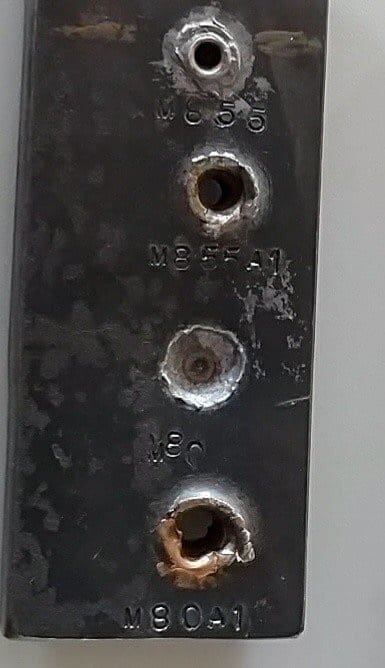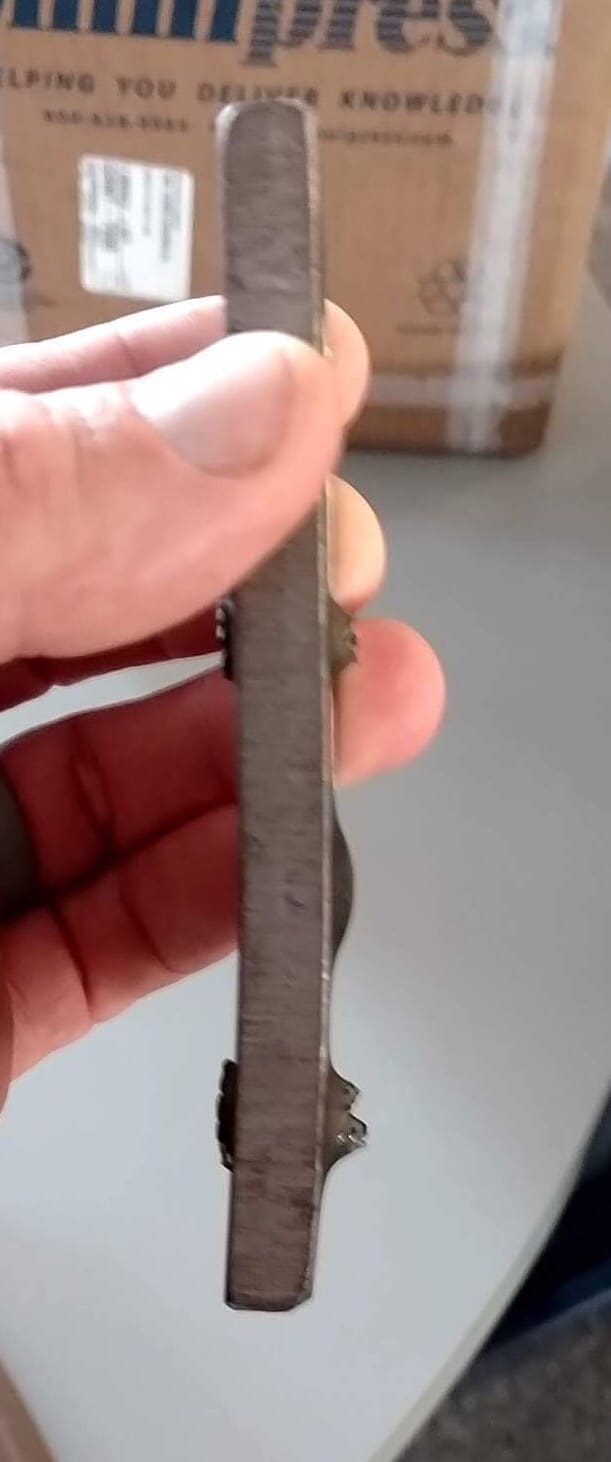Last month, Chief of Staff of the Army, GRN Mark Milley gave testimony before the Senate Armed Services Committee regarding an unspecified, new 7.62 round which can defeat threat body armor. The Program Manager, Maneuver Ammunition Systems recently gave a presentation on the capabilities of the Army’s current small arms ammunition at Ft Bragg. This target coupon was shown as an example of 5.56mm and 7.62mm rounds being shot at 3/8″ mild steel from a distance of 300m.
Long story short, the ammunition is better than ever. The 5.56mm ammunition is optimized to offer the desired effect on target. Its 7.62mm equivalent, M80A1, went through that steel like a hot knife through butter.
Even the 5.56mm M855A1 makes quick work of threats, as long as it hits the target. The Army has excellent ammunition; now it needs to work on improving its combat marksmanship.
Photos via 82nd Airborne Division Master Gunner page on Facebook.




On the top pic, did the M855 completely pass through as well? I can see the 855A1 made a larger hole.
No, M855 did not penetrate.
Or I should say, did not penetrate through.
*perforate.
I thought I had read somewhere that the Army was considering the 6.5 CM and the 6.8 SPC as well as.
Is it accurate to assume that the focus is currently on the 7.62 NATO because its a NATO round?
Somewhat on target: the 7.62 has already had 60 years of infrastructure in the form of manufacturing, legal reviews, and product improvements in place. It’s far from a perfect round but all the homework’s already done, technology mature, legal reviews complete, etc. An imperfect bird in hand beats two perfect ones in years long competitions, protests, and cancellations.
I suspect the 260 Remington will likely be the 6.5mm variant that makes the short list due to compatibility with existing M13 links, 7.62 magazines, and other accoutrements. Derived from the 308, it’s an easy barrel (and iron sight) swap with little other development needed for the legions of existing GPMGs and rifles. It’s also an easier sell from the acquisitions angle: it’s an A(X) modification to existing weapon versus whole new procurement.
I thought I read something about the Army wanting a COTS rifle that didn’t require any modification or customization.
That is correct.
Right now, the Army isn’t considering anything. They won’t do anything until the SACS study is released, sometime soon.
What is the “legal” ramifications on why cannot use “true” hollow-point rounds or other expanding rounds for CQC or soft TGT’s? I thought I read in a paraphrase of the Geneva convention once and a possible anecdote that the reasoning behind the GC was from the late 19th century; “dum-dum” bullets were soft-nose and it was considered inhumane to injure or maim with these rounds, instead of a steel core or solid jacketed bullet.
Any help to explain this and why this cannot be re-written for CQC and soft tissue TGT’s?
Its not the Geneva convention. Its the Haague and the United States never signed it
Sooooo, does that mean “we” could use better ammo to defeat soft targets in a CQC environment then?
We are…it’s called M855A1 and it has excellent soft tissue performance.
If we are willing to sacrifice all of our protections under those agreements, and those of our allies, to use them, yes, we can do that.
One would be wise to review the actual history of the Hague and Geneva protocols, and research those things that went into it.
First of all, much of the animus against the so-called “Dum-Dum” prohibition arose out of great power politics, much as we can observe during the Cold War. Instead of Soviet hypocrisy decrying the West for doing things like the Pershing II that the Soviets couldn’t counteract on the battlefield, we have the earlier German Empire decrying the British Empire for “inhumanity”, supposedly because they were using “Dum-Dum” expanding bullets meant for use against colonial targets like Indians on Westerners, namely the Boer farmers of South Africa during the Boer War. And, that was without there actually being use of said rounds, in the first damn place…
Although, there are apocryphal stories of mistaken shipments being made, and issued. I haven’t ever been able to find legitimate documentation for the British actually employing these theoretical bullets, which remind me more of the supposed ceramic Glocks they were talking about back in the old days.
So, root cause for all this? Basically, power politics by those great hypocrites, the Imperial Germans–Who, shortly after this, started down the road of WMD by using battlefield chemical agents, which they had also tried to ban through treaties.
Then, there’s the logic of the whole thing: Supposedly, the ban on expanding bullets is to “reduce human suffering”. OK, think about that, for just a minute: These treaties and conventions came into being during a period when medicine lacked things like antibiotics and even sulfa drugs. So, the implication is then that it was somehow more “humane” to poke holes in someone, and let them die weeks later after suffering infection and God alone knows what horrors due to battlefield infection of their wounds, than to kill them quickly by allowing the use of expanding bullets that would create larger and more effective wounds which would rapidly kill them–“Inhumanely”.
The irony escaped them.
And, here we are: Today, the logic of all this has long since been made obsolete, and we’re now wanting to issue cartridges with projectiles that presumably should hand out teddy bears and candies as they impact the subjects of our fires. While, simultaneously, exposing our own troops to risk of death at the hands of our targets because their rounds are not reliable and rapid killers.
The whole thing is ludicrous, on the face of it all. The US should never have even paid lip service to this bullshit, and neither should anyone else. We cavil at using expanding rounds, while at the same time refusing to hold the enemy responsible for making war on us while remaining hidden among the civilians on the battlefield.
Insanity.
From what I’ve read we do actually used hollow point ammunition, or at least SOCOM does in certain circumstances. Namely during counter-terrorist/insurgent operations since they’re not recognized as uniformed soldiers and the JAG corps has determined that it’s therefor legal to use hollow points.
The cartridges we use are OTM (Open-Tipped Match), from what I understand, meaning that they’re not deliberately designed to expand, but are instead made with an open tip due to the manufacturing technique that results in more accurate projectiles. So, technically, they’re not “hollow-point ammunition” in the sense that they’re designed to expand.
Frankly, the whole discussion just aggravates the hell out of me–Primarily because of the hypocrisy that stems from it. The whole thing is supposedly predicated on “lessening human suffering”, right?
Soooo… Circa 1900, when all this crap was being negotiated by the great and the good, the precise mechanism of “lessening human suffering” was what, again? Oh, yeah–Let’s wound the poor bastards, contaminate the resultant wounds with whatever organic filth is on the battlefield, and then use pre-antibiotic early 20th Century medicine on the resultant wounds…
Oh, yeah–That’s a net gain for humanitarianism, that is. Frankly, the truly humanitarian thing to have been doing at that point would have been to demand the use of Dum-Dum bullets so that the poor bloody bastards you were shooting died as quickly as possible from the wound, instead of lingering for weeks with their flesh rotting off in so-called “hospitals”.
And, even today…? LOL… One of my old medics got to deal with some poor kid who followed the Jihadi trail into Afghanistan, got wounded by our guys with M4 carbines and M855 rounds back around 2004-ish. Dude got dragged off the battlefield after they tried ambushing our folks, and wound up rotting in some grape drying shed for a week or two. By the time the locals decided to hand his ass over to us for medical treatment…? Good God, but was that ugly–They had to amputate everything, and even with modern medicine, he wound up dying after several weeks lingering in one of our field hospitals. My medic commented that the sheer suffering inflicted on that poor bastard in trying to save his life a week or two after he got wounded was probably the cruelest punishment imaginable, and the amount of suffering the poor bastard went through was biblical.
Overall, I’m not so sure that the people agitating for this “humanity” in war really know what the hell they’re doing, or have the best interests of the combatants in mind. I’d really be very easily convinced that the majority of these “do-gooders” were actually some kind of depraved sadists who derived great sexual pleasure from the idea of some poor bastard taking weeks to die without modern medical care.
The whole thing is amazingly messed-up–Were you to do what we do with combat rounds in most US states for hunting ammunition…? Your ass would be going to jail, for inflicting unnecessary suffering on the game animals in question. With people, though? It’s like “Let’s make ’em hurt as much as possible, for as long as possible…”.
There’s no money in reforming marksmanship training. New toys equal post retirement jobs. There is no incentive to improve programs for the big army. Outside of SOF, the 18th Abn corps is likely the only organization that would bother implementing new training methodologies. Outside of that, you ha e occasional decent small arms training at company or BN levels when you have a few enthusiastic marksmen AND officers in the same place at the same time.
Otherwise, you still have units making their joes drag the covers off of water filled foxeholes and jumping in and out in full kit every three rounds – wondering why they can’t group and zero. And who cares, not like most of them will every have to use the thing.
Agreed – but I’m still flabbergasted by the idea that a 7.62 round is a cure-all for lethality when our joes still have trouble HITTING the target..
Our small arms are in a good place, despite the internet commandos. Now we need to actually train on them.
18th ABN corp as a whole doesn’t invest much time into training individual level marksmanship. 3 ID falls under 18th, and there is no corp level emphasis put on it. We just a got new DIV CDR however, and he is more involved with emphasizing marksmanship.
Like you said, it really falls on the small unit leaders, CO CDR and below, to instill a gunfighter mentality into the individual infantryman. What we are constantly fighting against is everything that inhibits us from training at the individual level. Bradley gunneries are far more important to the unit as a whole, so that is what we are directed to focus on.
That isn’t an 18th ABN Corps issue, that’s a Division/community focus. When I was in 1st Cav the focus was on crew quals and gunnery. Heavy units have typically placed a greater emphasis on that than individual weapons training.
I’d like to shake the hand of the guy who shot those rounds with such even spacing at 300m. Damn fine shooting.
I would hand him a beer
I could be wrong, but mechanical rests don’t drink beer. Using a human for terminal balistic testing is silly in this context.
Aside from these new projectiles’ penetration performances, I am impressed by the precision with which the demonstration rounds were evenly and precisely vertically dispersed on that steel at 300m!
They likely downloaded the round to replicate the velocity the round would strike the target at 300m and fired it from a test barrel. That would eliminate uncontrolled variables.